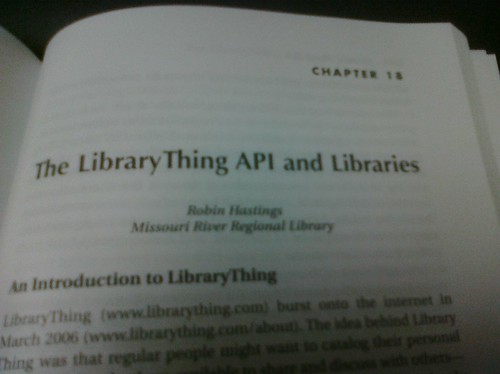My author copy of Library Mashups came today!! Here, below, is a camera-phone image of the header of the chapter I wrote for the book (Chapter 18: The LibraryThing API and Libraries). Wanna see more? Buy it!!

Tag: Writing
The Webgoddess in the media
A quote from an email interview I gave on using Twitter in my writing career is up at The Adventurous Writer. It’s a quick quote about how I got my book deal, but I thought I’d point you all to it anyway since there are lots of quotes from other writers in there too with interesting stories and ideas for using Twitter for writing.
The common discourse and you
I’m currently listening to a book on CD (errr, rather .wma, since I’ve checked it out from my local public library via netLibrary and am listening to it via the DRM-filled magic of Windows Media Player – but that’s another post entirely) called “Way With Words: Writing, Rhetoric, and the Art of Persuasion” that brought up an interesting point in the 4th lecture on Audience. The professor, Michael Drout, used the term “common discourse” to explain why you should go beyond knowing who your audience is and actually understand what the common culture of the audience. He used magazine articles as an example – read the magazine and understand what type of language is used (jargon; plain English; first, second or third person; etc.) and what conventions the audience expects. Since you can’t know who exactly will be in your audience, the next best thing would be to cater to what they expect from you. This comes on the heels of a post by Aaron Schmidt, of the Walking Paper blog that gives tips for being a good presenter. Michael Stephens saw that post and pointed to his own collection of tips for presenting at Tame The Web.
All of these things came together for me this morning in a sort of synthesis of information – which I’m going to share with you. Dr. Drout was referring to audience as a writer or speaker, Aaron and Michael were talking about speaking and presenting and this blog tends to talk about (when it’s not overtaken by conference posts) web sites and web site design. All of these creative endeavors require that you take into account your “audience” – but none of them have a well-defined audience at all. Anyone can read a magazine article, show up for a presentation or visit a web site. You may have a vague idea of the type of people who will show up (librarians interested in webby 2.0 stuff, such as the last conference I attended), but even within a fairly limited audience range, you will find vast differences in technological abilities, interests and understanding. Because of this difference, “writing for your audience” becomes pretty much useless advice.
Instead of writing for a particular audience type, check out the audience’s expectations via the common discourse. Use Slideshare to see what kinds of presentations were given at the last conference at which you are speaking; read a back issue or two of a magazine for which you want to write; visit similar or competing web sites that do much the same thing as the web site you are about to design/write copy for/etc. This will require a bit more work on our part as content creators, but it will – hopefully – improve the effects our words/presentations/sites have on our audience – and that’s the point of doing all this writing/presenting/web site creating, right?
Now that everything is officially official, I can let my loyal readers know what my next big project will be (besides 4 presentations in 3 months and a changeover from Exchange to Google hosted email)! While I was in Anaheim for ALA, I was approached at my table at the Social Software Showcase by an editor for the ALA Tech Source Tech Reports and asked if I’d like to write one for them. After some discussion of topic and timing, I can now say that the May/June 2009 issue of the Tech Report will be on Collaboration 2.0 (working title – it’ll probably change…) and will deal with using Web 2.0 tools (Facebook, Ning, Twitter, Flickr, etc.) to provide a platform for collaboration in libraries. I’m pretty excited about the project and am champing at the bit to get started! I’ll be doing some serious tapping into my social network to get examples of collaboration from my librarian buddies on Twitter, Facebook, Ning (starting to sound familiar?) and the like. Don’t feel like you have to wait to be asked, though, if you are doing some collaborative project and using these tools – feel free to drop me a line and let me know what you are doing any time!